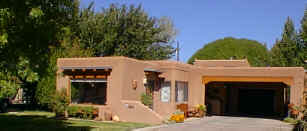Downtown Albuquerque on a 90-plus-degree summer day can be exhaustingly hot unless you are walking on a breezy, shady sidewalk. That same sidewalk in subfreezing weather can be harrowing, with skyscrapers blotting out the sun as strong winds nearly knock you down. Recognizing that our streets should ideally have both a sunny and a shady side to keep pedestrians cooler in the summer and warmer in the winter, Albuquerque planners have been challenged to explore ways of achieving these and other climate-controlling amenities. They are looking to, and taking a lesson from, neighboring cities whose formerly dry, hot, and pleasant climates have been replaced by stifling heat and humidity.
Climate planning in a downtown area is almost beyond solution because of the complex and interacting variables involved. The very nature of a built up area means there will be many buildings, many long shadows cast in the winter, and many miles of asphalt, concrete and metal that absorb and re-radiate heat. These materials have a further adverse effect on the climate because they shed rain water that could provide evaporative cooling.
The size and shape of buildings, the way they are oriented, the layout of streets, and the placement of trees all affect the wind, temperature, and even air-pollution concentration. Wind is one of Albuquerque's weather problems in all parts of the city. It is especially severe downtown where narrow streets and sidewalks, tall slab buildings, and north-south entrances help make it difficult to get around and almost impossible to open the heavy doors of our major public buildings.
The city has tried to affect the climate in built areas through landscaping and a street tree ordinance. Trees downtown are growing big enough to decrease radiant heat and to noticeably affect the micro-climate. However, the use of vegetation for climate control brings another kind of problem - water consumption. We use far more than is actually needed to keep plants alive. A delicate balance must be achieved between providing water for a growing population and for landscaping that can improve the quality of our lives. Proper selection of vegetation and common sense in irrigating can help resolve this dilemma.
In established urban centers such as downtown, the opportunities for coping with the built environment's effect on climate are limited. But Albuquerque is still growing up and out. Planners are trying to blend knowledge of the past with the high-tech assistance of our computer age in the new construction projected for uptown and the mesa.
 |
Looking to the past, planners note that sometimes the old ways are best. Traditional building patterns were very respectful of the climate. The old covered walkways and portals in Santa Fe, Taos, and Old Town made a lot of sense. They protected people from the weather and made walking around quite pleasant. Many of the enclosed courtyards were well adapted to our region's needs. They kept winds out and created desirable micro-climates within living areas We find less of that common sense in today's designs. Even the pueblo-style architecture so popular in Albuquerque today is only a copy of the real thing and has lost much in translation. Unfortunately, the wood-frame construction with stucco on the outside may look like pueblo architecture, but doesn't enhance livability or insulation.
The original architecture succeeded because of its mass and the building materials used. The evolution in building materials has resulted in superficial replication of the early style without the climate-controlling benefits it used to offer.
The problems are complex, but planners are not giving up. Computers are opening up a new world to them. Computer modeling is going to be very important in finally and comprehensively looking at the urban center and considering climate, energy and water consumption, and land-use planning.
* Adapted from "Life Can Be So Sweet on the Sunny Side of the Street," by Anthony Della Flora, IMPACT, Albuquerque Journal Magazine
(Up to Section II, Back to Urban Design, On to Central Avenue as an Alpha Street)